View in other NatureServe Network Field Guides
NatureServe
Montana
Utah
Wyoming
Idaho
Wisconsin
British Columbia
South Carolina
Yukon
California
New York
Olive-backed Pocket Mouse - Perognathus fasciatus
Native Species
Global Rank:
G5
State Rank:
S5
(see State Rank Reason below)
Agency Status
USFWS:
USFS:
BLM:
External Links
State Rank Reason (see State Rank above)
Species is uncommon across central and eastern Montana in suitable habitats. It occupies both grazed and ungrazed lands and has no known threats.
General Description
The Olive-backed Pocket Mouse (Wyoming Pocket Mouse) measures at most 5 5/8 inches as an adult, with its tail being half or more of that length. It weighs under 1/2 ounce. Its silky fur is olive-gray, with a top band of black and olive (Zeveloff and Collett 1988). A yellowish-buff line marks its sides and the patches of fur behind its ears are light yellow. It is buffy to pure white below. Like all the members of its biological family, it has fur-lined cheek pockets for storing food, which open on each side of its mouth. The well-developed legs and 3/4-inch-long hind feet enable it to hop and jump. Active at night, the Olive-backed Pocket Mouse's eyes appear to glow with a faded amber light. It has 20 teeth, the upper incisors having grooved faces (Burt and Grossenheider 1964).
Species Range
Montana Range
Range Descriptions
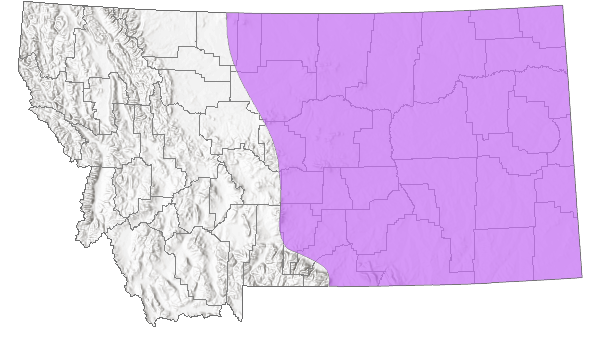
 Native
Native
Western Hemisphere Range
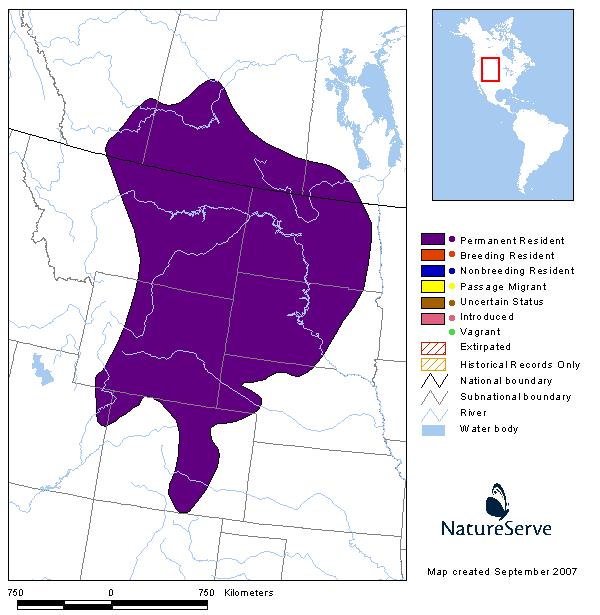
Observations in Montana Natural Heritage Program Database
Number of Observations: 141
(Click on the following maps and charts to see full sized version)
Map Help and Descriptions
Relative Density
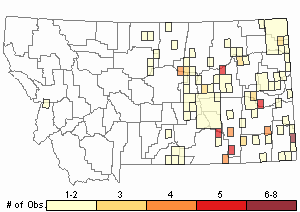
Recency
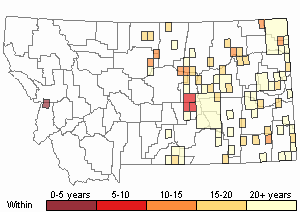
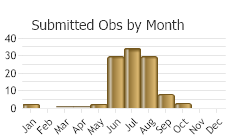
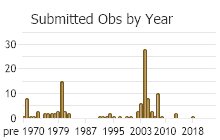
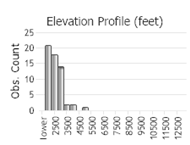 (Observations spanning multiple months or years are excluded from time charts)
(Observations spanning multiple months or years are excluded from time charts)
Migration
Non-migratory.
Habitat
A wide variety of grassland and soil types. Grazed and ungrazed meadows on sandy soils, shortgrass and sage near sandy draw. Sage-grassland, creek and grassland types.
National Vegetation Classification System Groups Associated with this Species
Forest and Woodland
Low Elevation - Xeric Forest and Woodland
Shrubland
Sagebrush Shrubland
Grassland
Lowland - Prairie Grassland
Sparse and Barren
Sparse and Barren
Wetland and Riparian
Alkaline - Saline Wetlands
Riparian and Wetland Forest
Riparian Shrubland
Recently Disturbed or Modified
Introduced Vegetation
Recently Burned
Human Land Use
Developed
Food Habits
Can obtain metabolic water from digestion of dry seeds.
Ecology
An active burrower. Usually plugs entrances in daytime. Locomotion is by quadrupedal hopping, sometimes by walking. Rests on hind feet and tail when gathering food. Harvests with forepaws.
Reproductive Characteristics
Bimodal peaks in production during parturition period suggests the possibility of two litters/year, but still unclear. Breeding season begins in April.
Stewardship Responsibility
References
- Literature Cited AboveLegend:
 View Online Publication
View Online Publication Burt, W.H. and R.P. Grossenheider. 1964. A field guide to the mammals. Houghton Mifflin Co.
Burt, W.H. and R.P. Grossenheider. 1964. A field guide to the mammals. Houghton Mifflin Co. Zeveloff, S.I. and F.R. Collett. 1988. Mammals of the Intermountain west. University of Utah Press, Salt Lake City, Utah.
Zeveloff, S.I. and F.R. Collett. 1988. Mammals of the Intermountain west. University of Utah Press, Salt Lake City, Utah.
- Additional ReferencesLegend:
 View Online Publication
View Online Publication
Do you know of a citation we're missing? Bachen, D.A. 2014. Cheatgrass invasion of sagebrush steppe: Impacts of vegetation structure on small mammals. M.Sc. Thesis. Bozeman, Montana: Montana State University. 96 p.
Bachen, D.A. 2014. Cheatgrass invasion of sagebrush steppe: Impacts of vegetation structure on small mammals. M.Sc. Thesis. Bozeman, Montana: Montana State University. 96 p. Bauer, Delane, 2002, 2002 Four Seasons Wildlife Study. Savage Mine Report, Richland County, Montana.
Bauer, Delane, 2002, 2002 Four Seasons Wildlife Study. Savage Mine Report, Richland County, Montana. Bramblett, R.G., and A.V. Zale. 2002. Montana Prairie Riparian Native Species Report. Montana Cooperative Fishery Research Unit, Montana State University - Bozeman.
Bramblett, R.G., and A.V. Zale. 2002. Montana Prairie Riparian Native Species Report. Montana Cooperative Fishery Research Unit, Montana State University - Bozeman. Dames & Moore. 1975. Interim report environmental baseline studies for Crow Indian coal leases: known as Tract II and Tract III, Westmoreland Resources, Sarpy Creek Basin, Big Horn County, Montana. Billings, Mont.
Dames & Moore. 1975. Interim report environmental baseline studies for Crow Indian coal leases: known as Tract II and Tract III, Westmoreland Resources, Sarpy Creek Basin, Big Horn County, Montana. Billings, Mont. Dood, A.R. 1980. Terry Badlands nongame survey and inventory final report. Montana Department of Fish, Wildlife, and Parks and Bureau of Land Management, Helena, MT. 70 pp.
Dood, A.R. 1980. Terry Badlands nongame survey and inventory final report. Montana Department of Fish, Wildlife, and Parks and Bureau of Land Management, Helena, MT. 70 pp. Foresman, K.R. 2001. The wild mammals of Montana. American Society of Mammalogists, Special Publication Number 12. Lawrence, KS. 278 pp.
Foresman, K.R. 2001. The wild mammals of Montana. American Society of Mammalogists, Special Publication Number 12. Lawrence, KS. 278 pp. Foresman, K.R. 2012. Mammals of Montana. Second edition. Mountain Press Publishing, Missoula, Montana. 429 pp.
Foresman, K.R. 2012. Mammals of Montana. Second edition. Mountain Press Publishing, Missoula, Montana. 429 pp. Gniadek, S. 1983. Southwest Glendive Wildlife Baseline Inventory. Miles City, Mont: Bureau of Land Management, Miles City District Office. 56 pp with appendices.
Gniadek, S. 1983. Southwest Glendive Wildlife Baseline Inventory. Miles City, Mont: Bureau of Land Management, Miles City District Office. 56 pp with appendices. Hanauska-Brown, L., B.A. Maxell, A. Petersen, and S. Story. 2014. Diversity Monitoring in Montana 2008-2010 Final Report. Montana Fish, Wildlife & Parks. Helena, MT. 78 pp.
Hanauska-Brown, L., B.A. Maxell, A. Petersen, and S. Story. 2014. Diversity Monitoring in Montana 2008-2010 Final Report. Montana Fish, Wildlife & Parks. Helena, MT. 78 pp. Hoffmann, R.S. and D.L. Pattie. 1968. A guide to Montana mammals: identification, habitat, distribution, and abundance. Missoula, MT: University of Montana. 133 p.
Hoffmann, R.S. and D.L. Pattie. 1968. A guide to Montana mammals: identification, habitat, distribution, and abundance. Missoula, MT: University of Montana. 133 p. Joslin, Gayle, and Heidi B. Youmans. 1999. Effects of recreation on Rocky Mountain wildlife: a review for Montana. [Montana]: Montana Chapter of the Wildlife Society.
Joslin, Gayle, and Heidi B. Youmans. 1999. Effects of recreation on Rocky Mountain wildlife: a review for Montana. [Montana]: Montana Chapter of the Wildlife Society. Kritzman, E.B. 1977. Little mammals of the Pacific Northwest. Pacific Search Press, Seattle, WA.
Kritzman, E.B. 1977. Little mammals of the Pacific Northwest. Pacific Search Press, Seattle, WA. Lampe, R.P., J.K. Jones Jr., R.S. Hoffmann, and E.C. Birney. 1974. The mammals of Carter County, southeastern Montana. Occa. Pap. Mus. Nat. Hist. Univ. Kan. 25:1-39.
Lampe, R.P., J.K. Jones Jr., R.S. Hoffmann, and E.C. Birney. 1974. The mammals of Carter County, southeastern Montana. Occa. Pap. Mus. Nat. Hist. Univ. Kan. 25:1-39. MacCracken, J.G., D.W. Uresk, and R.M. Hansen. 1985. Rodent-vegetation relationships in southeastern Montana. Northwest Science 59:272-278.
MacCracken, J.G., D.W. Uresk, and R.M. Hansen. 1985. Rodent-vegetation relationships in southeastern Montana. Northwest Science 59:272-278. Manning, R.W. and J.K. Jones, Jr. 1988. Perognathus fasciatus. Mammalian Species 303:1-4.
Manning, R.W. and J.K. Jones, Jr. 1988. Perognathus fasciatus. Mammalian Species 303:1-4. Martin, P.R., K. Dubois and H.B. Youmans. 1981. Terrestrial wildlife inventory in selected coal areas, Powder River resources area final report. Montana Department of Fish, Wildlife and Parks and Bureau of Land Management, Helena, MT. No. YA-553-CTO- 24. 288 p.
Martin, P.R., K. Dubois and H.B. Youmans. 1981. Terrestrial wildlife inventory in selected coal areas, Powder River resources area final report. Montana Department of Fish, Wildlife and Parks and Bureau of Land Management, Helena, MT. No. YA-553-CTO- 24. 288 p. Matthews, W.L. 1980a. Wibaux-Beach comparison study: Sydney, Glendive and Plevna Study Areas. Bureau of Land Management, Miles City, MT. 50 p.
Matthews, W.L. 1980a. Wibaux-Beach comparison study: Sydney, Glendive and Plevna Study Areas. Bureau of Land Management, Miles City, MT. 50 p. Pefaur, J. E., and R. S. Hoffmann. 1975. Studies of small mammal populations at three sites on the Northern Great Plains. Occasional Papers of the Museum of Natural History, University of Kansas, Lawrence. No. 37:1-27.
Pefaur, J. E., and R. S. Hoffmann. 1975. Studies of small mammal populations at three sites on the Northern Great Plains. Occasional Papers of the Museum of Natural History, University of Kansas, Lawrence. No. 37:1-27. Pefaur, J.E. and R.S. Hoffmann. 1971. Merriam's shrew and hispid pocket mouse in Montana. American Midland Naturalist 86(1):247-248.
Pefaur, J.E. and R.S. Hoffmann. 1971. Merriam's shrew and hispid pocket mouse in Montana. American Midland Naturalist 86(1):247-248. Pefaur, J.E. and R.S. Horrman. 1973. Notes on the biology of the Olive-backed Pocket Mouse (Perognathus fasciatus) on the Northern Great Plains. Prairie Naturalist 6(1)7-15.
Pefaur, J.E. and R.S. Horrman. 1973. Notes on the biology of the Olive-backed Pocket Mouse (Perognathus fasciatus) on the Northern Great Plains. Prairie Naturalist 6(1)7-15. Perry, N. and R. Davis. 2000. Small Mammal Diversity and Abundance on Two Habitat Types at Medicine Lake and Lostwood National Wildlife Refuges. Unpublished report. 8 pp.
Perry, N. and R. Davis. 2000. Small Mammal Diversity and Abundance on Two Habitat Types at Medicine Lake and Lostwood National Wildlife Refuges. Unpublished report. 8 pp. Powder River Eagle Studies, Gillette, WY., 1992, Big Sky Mine 1991 wildlife monitoring studies. Rev. February 1992.
Powder River Eagle Studies, Gillette, WY., 1992, Big Sky Mine 1991 wildlife monitoring studies. Rev. February 1992. Powder River Eagle Studies, Inc., Gillette, WY., 1996, Spring Creek Mine 1995 Wildlife Monitoring Studies. Spring Creek Coal Company 1995-1996 Mining Annual Report. Vol. I, App. I. May 1996.
Powder River Eagle Studies, Inc., Gillette, WY., 1996, Spring Creek Mine 1995 Wildlife Monitoring Studies. Spring Creek Coal Company 1995-1996 Mining Annual Report. Vol. I, App. I. May 1996. Reid, F. 2006. Peterson Field Guide to Mammals of North America, 4th Edition. Houghton Mifflin Company: Boston and New York, 608 pp.
Reid, F. 2006. Peterson Field Guide to Mammals of North America, 4th Edition. Houghton Mifflin Company: Boston and New York, 608 pp. Schladweiler, Philip, and John P. Weigand., 1983, Relationships of endrin and other chlorinated hydrocarbon compounds to wildlife in Montana, 1981-1982. September 1983.
Schladweiler, Philip, and John P. Weigand., 1983, Relationships of endrin and other chlorinated hydrocarbon compounds to wildlife in Montana, 1981-1982. September 1983. Scow, K.L. 1981. Ecological distribution of small mammals at Sarpy Creek, Montana, with special consideration of the Deer Mouse, Peromyscus maniculatus. M.Sc. Thesis. Bozeman, Montana: Montana State University. 73 p.
Scow, K.L. 1981. Ecological distribution of small mammals at Sarpy Creek, Montana, with special consideration of the Deer Mouse, Peromyscus maniculatus. M.Sc. Thesis. Bozeman, Montana: Montana State University. 73 p. Thompson, L.S. 1981. Circle West wildlife monitoring study: Third annual report. Technical report No. 8. Montana Department of Natural Resources and Conservation. Helena, Montana.
Thompson, L.S. 1981. Circle West wildlife monitoring study: Third annual report. Technical report No. 8. Montana Department of Natural Resources and Conservation. Helena, Montana. Tschache, O.P. 1970. Effects of ecological changes induced by various sagebrush control techniques on small mammal populations. M.Sc. Thesis. Bozeman, MT: Montana State University. 51 p.
Tschache, O.P. 1970. Effects of ecological changes induced by various sagebrush control techniques on small mammal populations. M.Sc. Thesis. Bozeman, MT: Montana State University. 51 p. Waage, Bruce C., 1991, Western Energy Company Rosebud Mine, Colstrip, Montana: Annual Wildlife Monitoring Report, 1990 Field Season. September 1991.
Waage, Bruce C., 1991, Western Energy Company Rosebud Mine, Colstrip, Montana: Annual Wildlife Monitoring Report, 1990 Field Season. September 1991. Waage, Bruce C., 1995, Western Energy Company Rosebud Mine, Colstrip, Montana:1994 Annual Wildlife Monitoring Report; December 1, 1993 - November 30, 1994. February 27, 1995.
Waage, Bruce C., 1995, Western Energy Company Rosebud Mine, Colstrip, Montana:1994 Annual Wildlife Monitoring Report; December 1, 1993 - November 30, 1994. February 27, 1995. Waage, Bruce C., 1996, Western Energy Company Rosebud Mine, Colstrip, Montana: 1995 Annual Wildlife Monitoring Report; December 1, 1994 - November 30, 1995. February 28, 1996.
Waage, Bruce C., 1996, Western Energy Company Rosebud Mine, Colstrip, Montana: 1995 Annual Wildlife Monitoring Report; December 1, 1994 - November 30, 1995. February 28, 1996. Waage, Bruce C., 1999, Western Energy Company Rosebud Mine, Colstrip, Montana: 1998 Annual Wildlife Monitoring Report; December 1, 1997 - November 30, 1998 Survey Period. February 24, 1999.
Waage, Bruce C., 1999, Western Energy Company Rosebud Mine, Colstrip, Montana: 1998 Annual Wildlife Monitoring Report; December 1, 1997 - November 30, 1998 Survey Period. February 24, 1999. Western Technology and Engineering, Inc. (WESTECH). 1994. Wildlife Monitoring Absaloka Mine Area Annual Report, 1993. Montana SMP 85005. OSMP Montana 0007c. Mar. 12, 1994.
Western Technology and Engineering, Inc. (WESTECH). 1994. Wildlife Monitoring Absaloka Mine Area Annual Report, 1993. Montana SMP 85005. OSMP Montana 0007c. Mar. 12, 1994. Western Technology and Engineering, Inc. (WESTECH)., 1994, Wildlife Monitoring Absaloka Mine Area Annual Report, 1994. Montana SMP 85005. OSMP Montana 0007D. Febr. 24, 1994.
Western Technology and Engineering, Inc. (WESTECH)., 1994, Wildlife Monitoring Absaloka Mine Area Annual Report, 1994. Montana SMP 85005. OSMP Montana 0007D. Febr. 24, 1994. Westmoreland Resources, Inc., Hardin, MT., 1983, 1980 Wildlife Monitoring Report. 12/21/79-12/20-80.
Westmoreland Resources, Inc., Hardin, MT., 1983, 1980 Wildlife Monitoring Report. 12/21/79-12/20-80.
- Web Search Engines for Articles on "Olive-backed Pocket Mouse"
- Additional Sources of Information Related to "Mammals"





